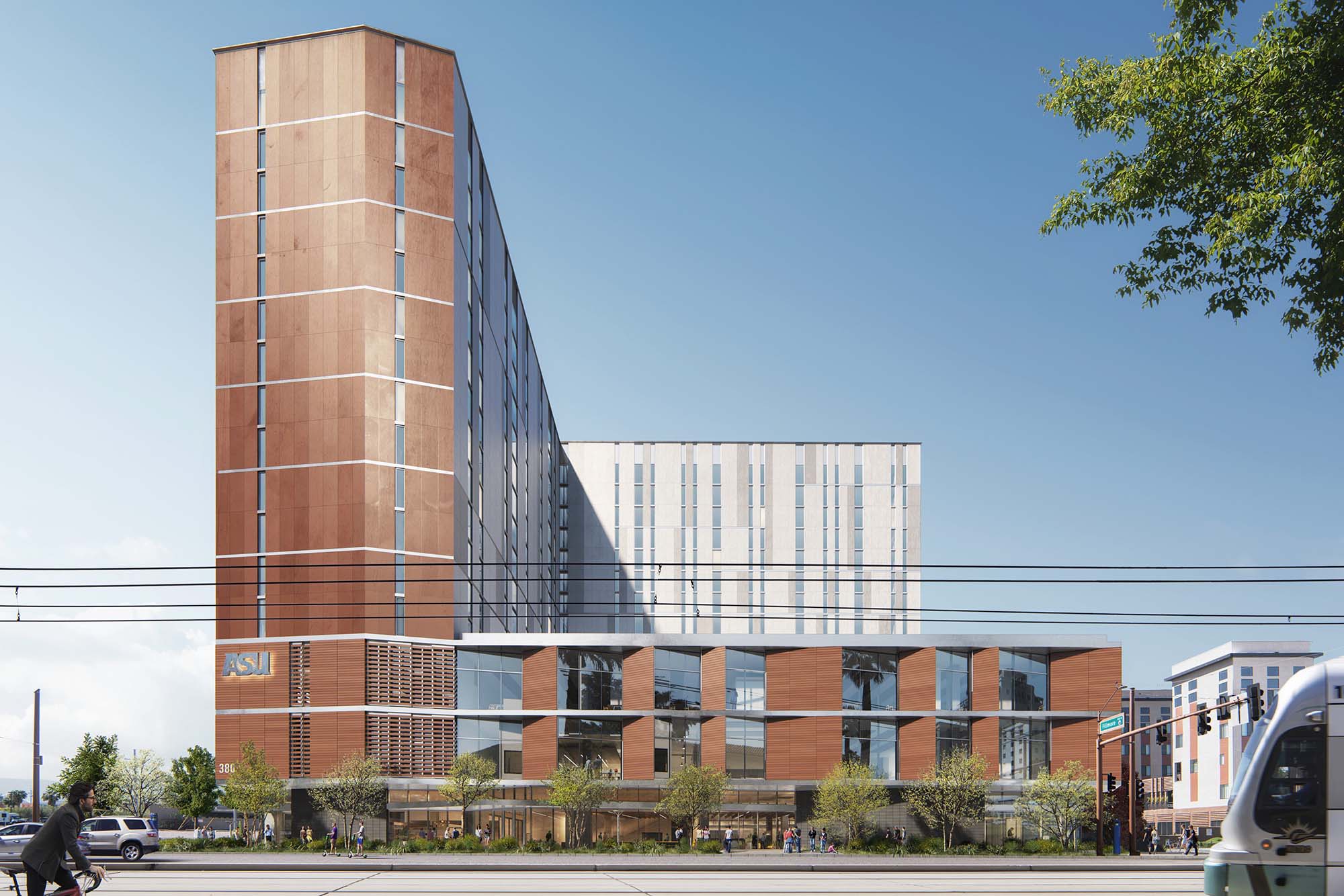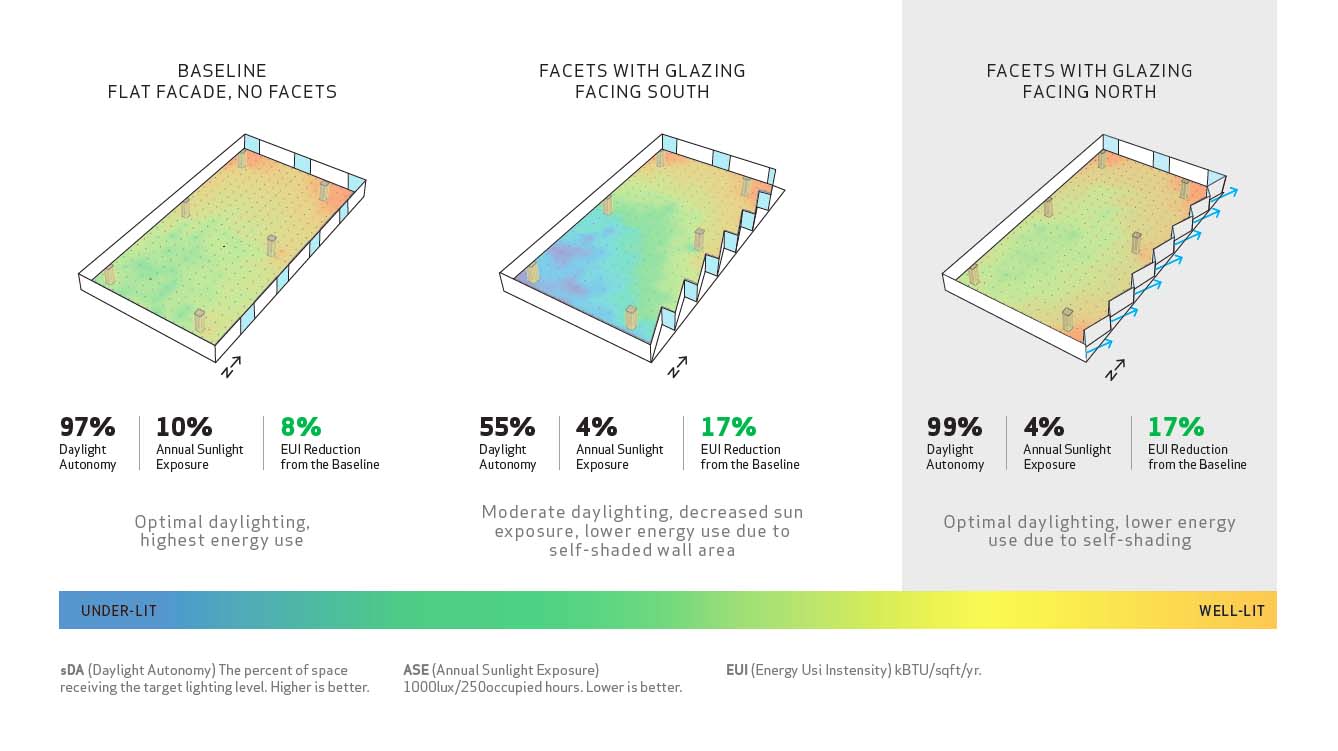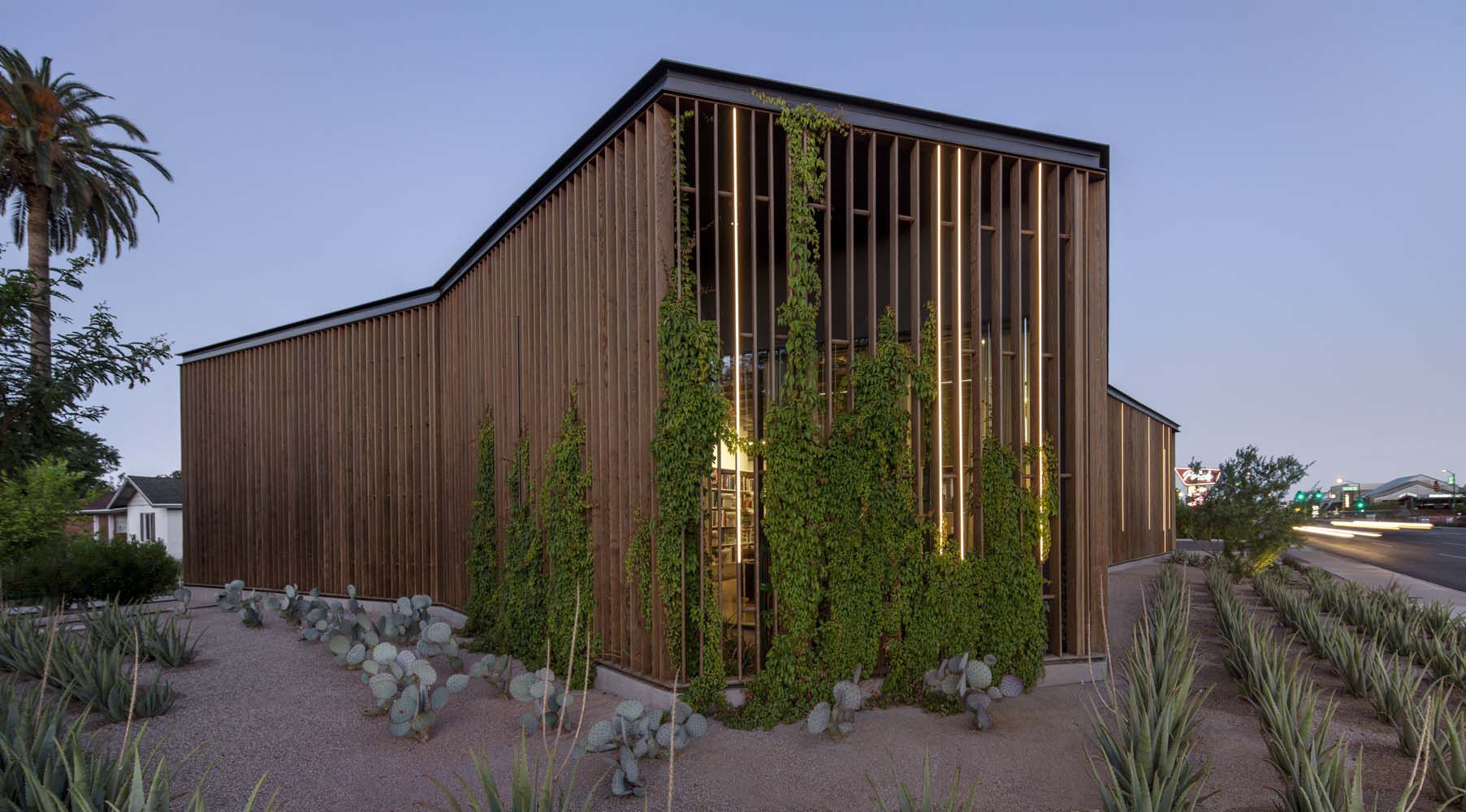Archives
Desert Urbanism: An architectural blueprint for a warming planet?
The work of Phoenix-based Studio Ma, which blends low-energy design and climate technology, offers something of a bellwether for sustainable building.

The design of Arizona State’s new residence tower, in downtown Phoenix, used exhaustive studies and digital tools to reduce the heat and glare from the desert climate while consuming as little energy as possible. (Image: Courtesy of Studio Ma)
Over the last two years, the architecture firm Studio Ma has been designing a 13-story residence hall atop a three-story arts hub for Arizona State University in downtown Phoenix, set to open in the fall of 2021. The form of the L-shaped residence tower on its rectangular base was derived from exhaustive studies, using cutting-edge technology, to reduce the heat and glare from the desert climate while consuming as little energy as possible. Christiana Moss, principal and co-founder of Studio Ma, compares the building’s skin to the self-shading saguaro cactus.
The new dorm is just the latest example of how Studio Ma has been designing sustainably in the desert, and elsewhere, for nearly two decades. The firm provides clients with a path toward becoming (or nearly becoming) “net zero” — buildings that generate, on site, the same amount of energy they use — whether or not that goal is explicit in the client’s contract. “So that we can show people it’s possible,” says Moss. While the ASU dorm is not net-zero, for example, it was designed in accordance with guidelines from the National Institute of Building Sciences on high-performance buildings, which optimize energy efficiency, durability, life-cycle performance, and occupancy comfort.
Studio Ma’s other local projects include the firm’s own net zero office in downtown Phoenix, other collaborations with Arizona State University, and Scottsdale’s Museum of the West. But Studio Ma also applies its approach beyond the Southwest region. For Washington University in St. Louis, the firm recently completed a comprehensive and prescriptive plan for achieving triple net zero (neutral consumption of energy, water, and waste) on part of the campus over a 25-year period. And Moss and her team are working with the U.S. State Department to advance resiliency and sustainability at embassies.
The reason for the broad interest is clear: As the climate heats up everywhere, sustainable desert buildings offer something of a bellwether for the future of urban design. The inherent tension between keeping people cool in places like Phoenix and keeping the planet cool has only grown; 2019 was the second-warmest year since records began in 1880, according to NASA. “We are in an extreme environment, but it also anticipates the state of the world,” says Moss. “The strategies that we need to embrace here have high applicability.”
For Studio Ma, those strategies might best be described as “desert urbanism” — turning back the clock to a time when architecture more closely reflected its immediate environment. The basic tenets are as old as the pueblos: Buildings should be oriented east-west to avoid maximum sun exposure and heat gain, incorporate substantial shade on a large scale, and capture breezes through a series of shaded, passive spaces. But what makes Studio Ma’s work even more unique is its use of technology to deliver these past precedents into the urban future.
Getting real-time design feedback
Moss and her husband, Christopher Alt, founded Studio Ma in 2003. The couple met as undergraduates while studying architecture at Cornell University and fled their theory-laden classes for a semester at the Oslo School of Architecture and Design. When Moss and Alt made their home in Phoenix in 1997, they infused their work with what they had absorbed in Norway: a respect for spirit of place, context, and climate, and a reverence for daylight, an element of architecture that can be as oppressive or liberating as any building material.
Maximizing daylight while protecting a building’s occupants from the relentless, arid desert heat and minimizing energy consumption is a big part of the delicate dance of sustainability in the Southwest. Moss says the region’s climate means “you have to shade glass completely,” but one wouldn’t know it to look at the ubiquitous mirrored glass and concrete towers of downtown Phoenix. “I feel like there’s still a tremendous amount of market-driven ignorance out there,” she says. “Developers and luxury buyers want to have limitless amounts of glass.”
She’s trying to do her part to change that. Studio Ma’s 14-person office has invested in software to measure daylight control, as well as other design impacts such as site placement, orientation, building massing, and photovoltaic energy potential. Most recently, the studio has been a beta tester for software called ClimateStudio, which they put to work to help them design the new dorm and academic building for ASU.
Created by Solemma, a small team of designers and scientists, ClimateStudio is one of the fastest and most accurate simulation tools on the market for annual illuminance, glare, and thermal comfort distributions in both day-lit and artificially-lit spaces. Based on real-world materials, benchmarks, glazing products, and American Society of Heating, Refrigerating and Air-Conditioning Engineers standards, the software operates in Rhino, a common 3D-modeling tool used by architects.
For the ASU dorm, Studio Ma needed the software to do some heavy lifting. To begin, the development site ran north-south, making it difficult to control exposure to daylight and solar heat gain. Additionally, each dorm room needed a window, and ASU wanted a lot of transparency at the street level, to play nice with an adjacent park. All of this prompted the need for a detailed lighting and energy strategy. The question, as Alt puts it, was: “How do we get glass on the east face of the building and make it properly day-lit, but protect from glare and too much heat gain?”

To help reduce energy use for the ASU dorm, Studio Ma used ClimateStudio to study how design tweaks would impact daylight, ultimately landing on a decision to facet the north facade. (Image: Courtesy of Studio Ma)
Studio Ma plugged a “control” building design (essentially a rectangular box) into ClimateStudio and began to see which tweaks resulted in optimal daylighting but minimal energy use. The answer: faceting the north façade. With this change, the building achieves 99 percent “daylight autonomy” (the percentage of space receiving the target lighting level) and just 4 percent annual sunlight exposure (a metric to help designers limit direct sunlight in a space over the course of a year). As a result, the architects reduced the energy use intensity 17 percent from their control design. Cladding the building in alternating solid and latticed panels of high-performance concrete further enhanced the building’s ability to shade itself.
The earliest version of ClimateStudio was created by Jon Sargent, a student at Harvard’s Graduate School of Design under building scientist Christoph Reinhart, who is now Solemma’s CEO. Sargent was frustrated that the software available at the time fell short of his and his fellow students’ desire to shape projects around building performance and human comfort. “It was hard to get real-time feedback on these questions,” says Sargent, now Solemma’s vice president of product. The tools he helped build gained traction at the GSD and other design schools.
Sargent and Reinhart commercialized Solemma in 2012, compelled by the urgency of climate change and believing that high-performance buildings shouldn’t only be available to a couple hundred engineers with extremely specialized skills or large architecture firms. “We don’t want the architect to replace the engineer,” says Reinhart. “But you don’t need to do a full energy analysis to look at what happens if I reduce my louvers by a bit. In minutes you can do some pretty advanced analysis.” ClimateStudio is now being used by some 60 architecture firms.
Putting “desert urbanism” into action
The ASU building is a great example of Studio Ma’s desert urbanism approach, the roots of which can be seen in a 2007 sustainability plan the architects worked on for downtown Phoenix. The firm collaborated on the public project with Harvey Bryan, a professor at ASU’s design school and its sustainability institute, specializes in the interface between building technology and the design of ecologically responsible environments. The plan emphasized an open space, pedestrian-intensive network of shaded streets, pocket parks, and dedicated “green connectors” that tied together major downtown destinations and retail zones. Bryan and Studio Ma proposed a zoning code that optimized building massing and street canyon sections to provide thermal comfort without worsening the urban heat island effect. Their work ultimately influenced Phoenix’s zoning code for the downtown, guiding the review of public and private development and investments, and formed the basis of Studio Ma’s thinking on local projects.
Bryan has also been the key educator for many of the interns that Studio Ma has recruited to perform energy analyses on their projects. He agrees that using glass sparingly in the desert is the most responsible design approach. He sees Studio Ma’s work as part of a long legacy of desert-adapted design, beginning with adobe pueblos built by earlier civilizations, which introduced mass to buildings and dampened heat flow.
More recently, Bryan sees Studio Ma’s work as fitting into the lineage of the “Arizona School,” a term coined about 20 years ago by Reed Kroloff, now the dean of the Illinois Institute of Technology’s College of Architecture, to describe a coherent body of work that shared “a sensibility, a vision for how to build in a particular, difficult place. It’s a desert sensibility, of course.”

Studio Ma designed its own office in downtown Phoenix to be both “net zero” and harmonious with the desert landscape. (Image: Courtesy of Bill Timmerman)
Bryan says today’s Arizona School must think outside of the box to achieve net zero and carbon-neutral buildings if Phoenix and other desert cities are going to become models of environmental adaptation. He’s optimistic about several technologies that are gaining traction to reduce cooling loads and solar gain, including evaporative cooling, phase change materials, and radiant cooling, and believes architects need to figure out ways to celebrate these strategies in their designs, rather than hiding them away like most mechanical systems, if they’re to achieve widespread adoption.
Bryan likes to bring his students to Arizona’s first net zero commercial office building, designed by SmithGroup. It’s a project that he thinks epitomizes how architects can harness a wide range of green building solutions and an example of desert urbanism. The building features an 87-foot solar chimney for a passive cooling system, operable windows that open and close according to indoor and outdoor temperatures, “Shower Towers” that bring water-cooled air into the office, solar optical tubes that eliminate the need for artificial light, and a photovoltaic canopy that covers half of the parking lot. As Bryan explains, all of these smaller-scale systems work at various times throughout the year to replace the need for one centralized air conditioning system.
“I think we need to be more regional about our responses, both in the built environment and other ways,” says Bryan. “We need to look to nature for our references, to how those systems have operated and worked, and move towards a more regional vocabulary.”
Many architects are now using Passive House standards to design sustainably in mixed-use, urban, high-rise contexts. But with its emphasis on triple window glazing and a super-tight building envelope, Passive House isn’t the most cost-effective way to achieve net zero construction in the desert, according to Moss. “The cost of getting to net positive, in some cases, could be better spent by adding more solar panels, a different mechanical system, or changing the orientation of your building.” And shading is critical. Studio Ma typically chases the even more progressive and holistic Living Building Challenge certification, which requires that projects generate all of their own energy with renewable resources, and capture and treat their own water — a particularly important move in the desert.
The tools, and the terms, for sustainable design are now abundant. But what is clear from Studio Ma’s work in the desert is that the labels aren’t as important as designing for the climate we have — that, to paraphrase architectural historian Marc Treib, our buildings must walk a very considered and strategic line between artifice and the forces of nature. “This is what we have to do,” says Moss. “This is our mandate as architects.”
Sidewalk Talk features are reported works focusing on planning, design, or technology innovations that can help improve urban life.